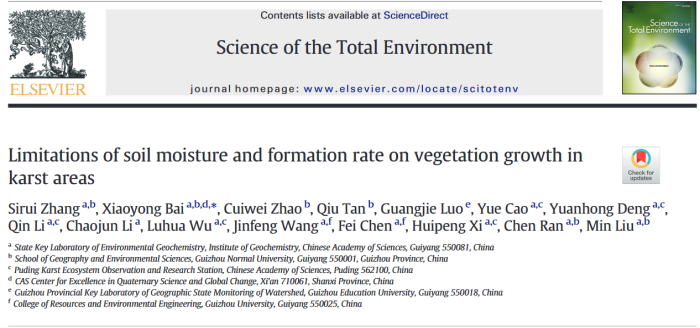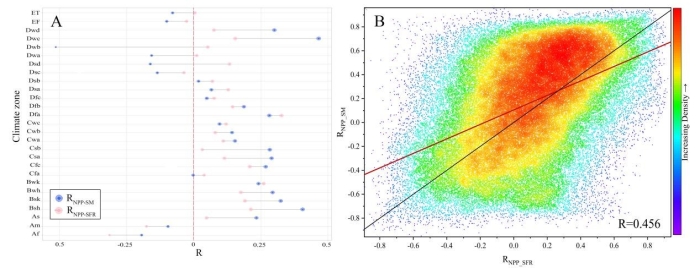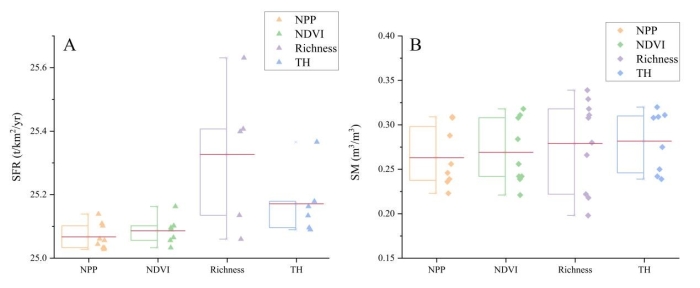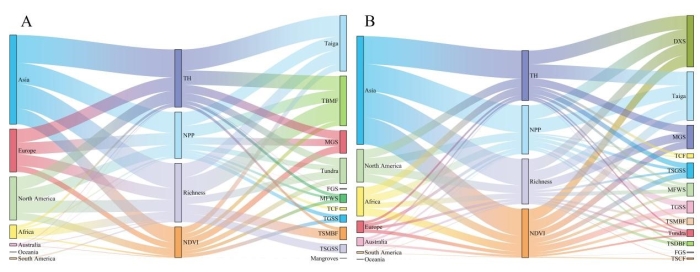封面英文:Limitations of soil moisture and formation rate on vegetation growth in karst areas
原创 张思蕊 白晓永 STOTEN全环境科学

图文摘要 | Graphical Abstract

导读 | Introduction
植被恢复是喀斯特地区石漠化治理的关键,成土速率(SFR)缓慢和较低的土壤湿度(SM)是制约植被恢复的重要原因。与其他地区明显不同,喀斯特地区土壤主要来源于岩石本身的化学风化成土,速率缓慢且土壤持水能力弱,从而导致了喀斯特地区较难形成茂密植被覆盖,生态系统脆弱。喀斯特地区土壤与植被相互作用机制是全球环境治理决策制定的重要支撑。本文研究了SFR和SM如何制约喀斯特植被生长,并利用皮尔逊相关分析法、Hurst指数法以及变点分析等方法量化SFR与SM对喀斯特地区植被生长影响的阈值并创建了2000-2014年全球0.125°×0.125°喀斯特生态系统静/动态限制关键区域空间信息图谱。
Vegetation restoration is the key to control rocky desertification in karst areas. Slow soil formation rate (SFR) and low soil moisture (SM) are important reasons to restrict vegetation growth. Different from other areas, the soil in karst area is mainly derived from the chemical weathering of the carbonate rock, which is slow and the water holding ability of soil is weak. It results in the difficulty of forming dense vegetation cover and the fragile ecosystem in karst area. The interaction mechanism between soil and vegetation in karst area is an important support for global environmental governance. Using Pearson correlation analysis method, hurst index and change-point analyzer, the threshold of SFR and SM on vegetation growth in karst areas were identified. Furthermore, a spatial map (0.125°×0.125°) of the global karst ecosystem with static/dynamic limitation zone was established. Today, let's take a look at how SFR and SM limit the vegetation growth in karst area.
一、SFR与SM对全球喀斯特地区植被的双重限制作用 | The dual limiting effects of SFR and SM on vegetation in global karst regions
植被生长指标和SFR以及SM相关性分析结果显示不同指标与二者的相关关系呈空间正相关(R=0.456, P<0.05)。以植被净初级生产力(NPP)为例,大多数地区的NPP受到SM与SFR的共同限制 (图 1)。当SFR对植物生长失去限制作用,表层SM的制约作用也同样在消失。全球70%以上气候带的喀斯特植被都明显表现出受SM与SFR的双重限制,并且受SFR单一限制的气候带植被更是占到了总数的88.46% (图 1A),这表明在除高温强降水地区以及低温弱降水量等极端气候地区外,全球喀斯特区域植被在任何气候条件下均受到SFR限制。
Through the correlation analysis of vegetation growth index and SFR and SM, it is shown that the correlation between the SFR-NPP correlation coefficient (RNpp-SFR) and (the SM-NPP correlation coefficient) RNpp-SM was positive (R=0.456, P<0.05). Take NPP of as an example, NPP in most regions was subject to the common limitation of SM and SFR (Fig. 1). When SFR lost its limiting effect on vegetation growth, this effect of surface SM was also disappearing. More than 70% of the global climate zones clearly showed the dual limitation of SM and SFR, and the climate zones constrained by SFR alone accounted for 88.46% of the total (Fig. 1A), which showed that except for extreme climate zone, the vegetation in the global karst areas was limitation by SFR.

图1 全球喀斯特地区SFR- NPP净初级生产力的相关系数(RNPP-SFR)和SM - NPP的相关系数(RNPP-SM)在柯本气候分类上的平均值(A)。和RNPP-SFR与RNPP-SM的相关性 (B)
Fig. 1 The average of RNPP-SFR (The SFR (soil formation rate) - NPP (net primary productivity) correlation coefficient) and RNPP-SM (The SM (soil moisture) - NPP correlation coefficient) in Karst on the K?ppen climate classification (A). And the correlation between RNPP-SFR and RNPP-SM (B)
二、喀斯特植被动态限制区| Dynamic limitation zone of vegetation in karst areas
根据SM与SFR自身变化趋势以及他们与各项植被指标的相关性,表1确定了NPP,植被归一化指数(NDVI)、植被丰富度(VR)和植被高度(TH)的动态限制区域(685.19 km2、615.13 km2、701.97 km2和382.06 km2)。令我们惊讶地是全球50%喀斯特植被的VR被限制,即使是受限最小的TH,都占到了全球喀斯特地区的26%。这表明SFR和SM的变化很大程度上影响着喀斯特地区植被的生长发育,并且上述植被生长指标対二者变化的响应敏感性也是区别的。
According to the change trend of SM and SFR and their correlation with various vegetation indicators, the dynamic limitation zones of NPP, NDVI, VR and TH (685.19 km2, 615.13 km2, 701.97 km2, 382.06 km2) were determined (Table 1). We estimated using the method above that 50% of the VR of karst in the world were the most strongly effected by limiting factors, and even the smallest limitation zone of TH accounted for 26% of the world's karst areas. This further supports that the changes of SFR and SM influenced the vegetation growth in karst areas to a greater extent, and the responses of vegetation characteristics mentioned above on them were also different.
表1 全球各植被指标受SFR与SM动态限制范围(104km2)
Table 1 The dynamic SFR (Soil Formation Rate)-limited and SM (Soil Moisture) -limited areas (104km2) for vegetation indicators
| only SFR AREA | only SM AREA | SFR&SM AREA | Limation AREA | Account for | ||
| NPP | 93.91 | 280.2 | 311.08 | 685.19 | 47.99% | |
| NDVI | 121.13 | 311.06 | 182.94 | 615.13 | 43.09% | |
| VR | 171.25 | 409.53 | 121.19 | 701.97 | 49.17% | |
| TH | 88.48 | 232.59 | 60.98 | 382.06 | 26.76% | |
| TOTAL | 1427.67 |
三、不同生态区的生态阈值 | Ecological thresholds in different ecological regions
本研究将全球划分成不同生态区以对其进行更加具体细致的分析,目的是在一定程度上控制分析区域内的气候变量。分析结果表明SRF与SM的阈值会在不同生态区中影响着一系列植被状态,但是这种影响的强度与广度都有着差异。。当SFR与SM分别为25.028 ~ 25.631 t/km2/yr和0.221~ 0.339 m3/m3时(图 2),植被的NPP、NDVI、VR和TH会出现跃迁现象,即出现阈值拐点。VR对SFR与SM的变化最不敏感,最大阈值均为VR所贡献,其均值也是其余平均阈值中最大的。我们认为只有当SFR与SM在大于各植物群落数量特征对应的阈值后,植被才会生长较好。
This study divided the world into different ecological regions for more specific and detailed analysis, and controlled the climate variables in these regions. The results showed that the thresholds of SRF and SM affected a series of vegetation states in different ecological regions, but the intensity and breadth of this influence were different. When the SFR and SM were 25.028 ~ 25.631 t km-2 yr-1 and 0.221~ 0.339 m3 m-3 (Fig. 2), different VI would show jump phenomena. VR was the least sensitive to changes in SFR and SM. The maximum threshold was all contributed by it, and its average value was also the largest among the average threshold values of other vegetation indicators. We believed that vegetation would grow better only when SFR and SM were greater than the threshold corresponding to the characteristics of each plant community.

图 2 全球喀斯特SFR(A)与SM(B)对不同植被指标的阈值统计
Fig. 2 Threshold statistics of global karst SFR (A) and SM (B) for different vegetation indicators
四、当前SFR和SM对岩溶植被的限制模式 | The current pattern in SFR and SM Limitation on karst vegetation
根据各植被指标所对应的SFR与SM阈值点的分析与确定,研究划定了2000-2014处于阈值点以下的植被静态限制区。对于大洲而言,亚洲喀斯特地区的植被状态相较于其他大洲可能更加危险(Fig.图 3),不论是SFR还是SM都大面积的限制的亚洲地区。尤其是NDVI和TH在大部分地区SM进一步加剧了SFR对植被的限制,主要位于青藏高原。对于生态区而言,明显看到土壤湿度所影响的植被种类多于SFR,泰加林不再像SFR是研究期内主要受限植被,而转变为沙漠草地受SM抑制最为广阔,即较大范围内植被均处于阈值以下。
According to the analysis of SFR and SM threshold points corresponding to each vegetation index, this study delineated the area below the threshold point from 2000 to 2014 as the static vegetation limitation zone. For the continents, the vegetation of Asian karst areas may be more dangerous than other continents (Fig. 3). Both SFR and SM limited a large of vegetation in Asia, especially in terms of NDVI and TH mainly located on the Qinghai-Tibet Plateau. For the ecological region, it is obvious that more vegetation types affected by SM were more than by SFR. Unlike distribution of vegetation which was affected by SFR, the area of SM inhibition in desert grassland was the most extensive.

图3全球喀斯特各大洲以及各生态区的SFR和SM对不同植被指标的限制流向
Fig. 3 SFR-limited and SM-limited diversion for vegetation indicators from different continents or ecological regions
总结 | Conclusions
本文综合考虑喀斯特地区SFR以及SM并选择NPP、NDVI、TH和VR作为植被生长指标,阐明植被对喀斯特典型环境因素(SFR和SM)的响应。通过判定SFR与SM对植被的共同限制情况以确定不同生态区下SFR与SM对植被各指标阈值。最终识别出其空间静/动态限制关键区域。结果表明喀斯特地区植被生长普遍受到SFR和SM的双重限制。本研究将喀斯特地区植物生长与土壤环境和地球化学过程联系起来为全球环境治理提供理论依据。
Considering SFR and SM in the karst areas and selected NPP), NDVI, and VR as vegetation growth indicators, this study tried to clarify the response of vegetation to typical karst environmental factors (SFR and SM). By judging the common limitation of SFR and SM on vegetation, their thresholds on vegetation in different ecological regions were determined. Finally, the key areas of its space static/dynamic limitation were identified. These results showed that vegetation growth is generally limited by both SFR and SM. It will link the vegetation growth with the soil environment and geochemical process in karst areas, so as to provide predict theoretical basis for global environmental governance.
本文内容来自ELSEVIER旗舰期刊Sci Total Environ第810卷发表的论文:
Zhang S.R., Bai X.Y., Zhao C.W., Tan Q., Luo G.J., Cao Y., Deng Y.H, Li Q., Li C.J., Wu L.H., Wang J.F., Chen F., Xi H.P., Ran C., Liu M., 2022. Limitations of soil moisture and formation rate on vegetation growth in karst areas. Sci Total Environ 810, 151209.
DOI: https://doi.org/10.1016/j.scitotenv.2021.151209.
第一作者:张思蕊 硕士

中国科学院地球化学研究所
在中国科学院地球化学研究所攻读博士。主要研究方向为喀斯特生态地质及环境变化。以第一作者或共同作者在Science of the Total Environment、Global Climate Change、Journal of Cleaner Production、Earth’s Future等国际期刊发表论文11篇。
通讯作者:白晓永 研究员

中国科学院地球化学研究所
中国科学院地球化学研究所研究员、博导,生态环境与资源利用研究中心主任,入选贵州省“百”层次人才;系贵州省省管专家;贵州省高级人民法院环境资源审判咨询专家;中国治沙暨沙业学会石漠化防治专业委员会副主任;中国自然资源学会自然资源信息系统专业委员会副主任;中国地质学会岩溶地质专委会委员;中国矿物岩石地球化学学会终身会员;联合国教科文组织国际岩溶中心授课教授;同时,入选世界自然保护联盟(IUCN)生态系统管理委员;入选国际地理联合会(IGU)地理系统建模委员会委员;全球旱区生态系统国际大科学计划(Global-DEP)成员等。目前担任《Science of the Total Environment》编委,《Frontiers in Plant Science》助理编辑、《Land》客座编辑等,任Nature Geoscience和Nature Communication等多个学术期刊审稿人。主要从事喀斯特系统岩石风化与区域生态的关联机制方面的研究,主持和承担了包括国家自然科学基金面上项目、联合基金重点项目在内的30项余项省部级以上重大项目/课题,其中1000万以上项目/课题11项。在有重要影响力的生态环境科学国际学术期刊发表论文140余篇,获授权发明专利29项,包括2项美国专利。
近2年在Sci Total Environ发表的其他论文:
1. Xi et al., 2021. The responses of weathering carbon sink to eco-hydrological processes in global rocks. Sci Total Environ 788, 147706.
2. Gong et al., 2020. Response of the weathering carbon sink in terrestrial rocks to climate variables and ecological restoration in China. Sci Total Environ 750, 141525.